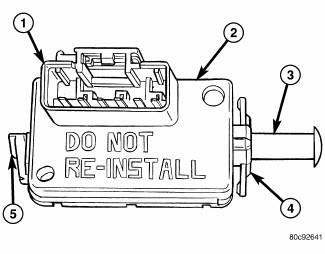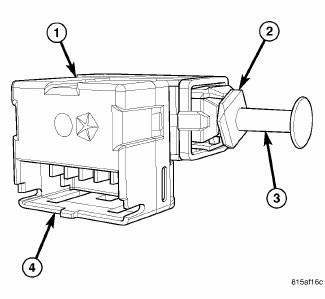Dodge Journey: Description, Operation
DESCRIPTION
Two unique brake lamp switches are used in this vehicle, depending upon whether the vehicle was built during early or late production. These switches are not interchangeable and both are illustrated and described in the paragraphs that follow.
EARLY PRODUCTION

Fig. 58: Brake Lamp Switch
This brake lamp switch (2) is a three circuit, spring-loaded plunger actuated switch that is secured to the brake pedal support bracket on the dash panel under the instrument panel on the driver side of the vehicle. The molded plastic switch housing has an integral connector receptacle (1) containing six terminal pins and featuring a Connector Position Assurance (CPA) lock. The switch is connected to the vehicle electrical system through a dedicated take out of the body wire harness.
The switch plunger (3) extends through a mounting collar (4) on one end of the switch housing. The plunger has a one time telescoping self-adjustment feature that is activated after the switch is installed by moving an adjustment release lever (5) on the opposite end of the switch housing clockwise, until it locks into a position that is horizontal and parallel to the connector receptacle.
This brake lamp switch cannot be readjusted or repaired. If the switch is damaged, ineffective, or removed from its mounting position for any reason, it must be replaced with a new unit.
LATE PRODUCTION

Fig. 59: Brake Lamp Switch
This brake lamp switch (1) is a three circuit, spring-loaded plunger actuated switch that is secured to the brake pedal support bracket under the instrument panel on the driver side of the vehicle. The molded plastic switch housing has an integral connector receptacle (4) containing six terminal pins. The switch is connected to the vehicle electrical system through a dedicated take out of the body wire harness.
The switch plunger (3) extends through a mounting collar (2) on one end of the switch housing. The plunger has a telescoping self-adjustment feature that is activated after the switch is installed by pulling the brake pedal upward to its normal at-rest position. The telescoping plunger can be pulled outward from the switch housing to repeat the self-adjustment procedure if necessary.
This brake lamp switch cannot be repaired. If the switch is damaged or ineffective it must be replaced with a new unit.
OPERATION
Both the early and late production brake lamp switches control three independent circuits. These circuits are described as follows:
- Brake Lamp Switch Circuit - A normally open brake lamp switch circuit receives a battery voltage input, and supplies this battery voltage to the Center High Mounted Stop Lamp (CHMSL) and the Totally Integrated Power Module (TIPM) on a brake lamp switch output circuit only when the brake pedal is depressed (brake lamp switch plunger released).
- Brake Lamp Switch Signal Circuit - A normally closed brake lamp switch signal circuit receives a direct path to ground, and supplies this ground input to the Powertrain Control Module (PCM) on a brake signal 1 circuit only when the brake pedal is released (brake lamp switch plunger is depressed).
- Speed Control Circuit - A normally closed speed control circuit receives a battery voltage input from the Totally Integrated Power Module (TIPM) on an ignition run/start control output circuit, and supplies this battery voltage to the PCM on a brake signal 2 circuit only when the brake pedal is released (brake lamp switch plunger is depressed).
The PCM sends electronic brake lamp switch status messages to other electronic modules in the vehicle over the Controller Area Network (CAN) data bus for use as an additional logic input for controlling many other vehicle functions and features.
The brake lamp switch as well as the hard wired inputs and outputs of the switch may be diagnosed using conventional diagnostic tools and procedures. However, conventional diagnostic methods will not prove conclusive in the diagnosis of the electronic controls and communication that provide some features related to brake lamp switch operation. The most reliable, efficient and accurate means to diagnose the electronic controls and communication related to brake lamp switch operation requires the use of a diagnostic scan tool. Refer to the appropriate diagnostic information.
 Diagnosis and Testing
Diagnosis and Testing
BRAKE LAMP SWITCH
WARNING: To avoid serious or fatal injury on vehicles equipped
with airbags, disable
the Supplemental Restraint System (SRS) before attempting any steering
wheel, s ...
See also:
Rod, piston and connecting
Description
Fig. 206: Piston & Connecting Rod
- "F" TOWARD FRONT OF ENGINE
- RING COMPRESSOR
- SPECIAL TOOL 8189
- OIL SQUIRT HOLE
The pistons (1) are made of a high stre ...
Installation
Fig. 25: Ball Joint Installation
1. Install Installer (2), Special Tool 9964-1, and Installer (4), Special
Tool 9964-2 on Remover/Installer (5),
Special Tool 8441-1. Place a new ball joint (stem ...
Removal
WARNING: Refer to the applicable warnings and cautions for this
system before
performing the following operation. Failure to follow these instructions
may
result in serious or fat ...

